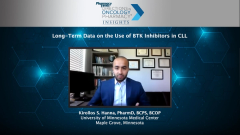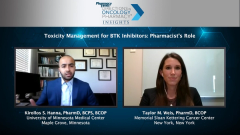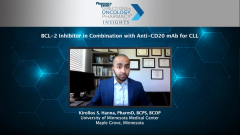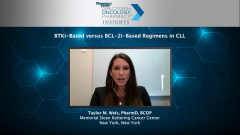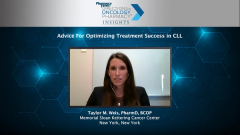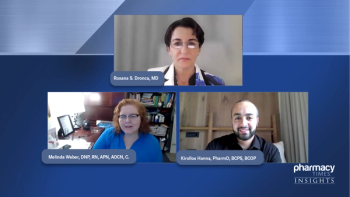
Emerging Therapies in CLL
Emerging combination therapies and novel agents being studied as initial therapy for CLL are discussed.
Episodes in this series

Kirollos S. Hanna, PharmD, BCPS, BCOP: What does the pipeline of CLL [chronic lymphocytic leukemia] therapies look like? We’ve seen this significant shift over the past several years, and I think there are a couple of notable trials we should highlight, or a couple of notable concepts, that are up and coming. Certainly, MRD [minimal residual disease] negativity is becoming a new favorable end point in the majority of clinical trials we’re seeing. Some of these include the CAPTIVATE study, for example. This is a phase 2 study that’s looking at a fixed-duration frontline treatment with BTK [Bruton tyrosine kinase] inhibition as well as BCL2, so it’s looking at ibrutinib in combination with venetoclax, and they are looking at various strategies. Patients will get a couple of months of ibrutinib, they will then be on venetoclax for a couple of months. Depending on MRD negativity, they will either been on placebo or be on ibrutinib to evaluate all these various schemas and approaches. One notable thing with a fixed duration, CR [complete response] rates were about 55% in some early data we saw in this phase 2 trial. There were only 80-something patients or so who were evaluated in this,but this is something notable that is, again, up and coming. It’s taking out the CD20 [monoclonal antibody] and putting on the BTK inhibition because we know how effective that is.
They’re also looking at various triplet regimens. There is something called the AVO regimen, which is looking at acalabrutinib, venetoclax, and obinutuzumab. This is another phase 2 trial. There were some results presented at ASH [American Society of Hematology annual meeting] in 2020, and patients had about 78% bone marrow MRD negativity, which is very impressive. MRD negativity in the peripheral blood versus the bone marrow or in lymph nodes, there are some differences. Again, these are very early data, and it’s going to be exciting for what we see; you’re combining here 3 primary mechanisms of action that have been big drivers in this disease state in general. Dr Weis, you already mentioned this, but there are some novel drugs too. The 3 BTK inhibitors that we have on the market, whether for CLL or not CLL, are all irreversible inhibitors of BTK. One thing that’s in the pipeline, up and coming, is reversible BTK inhibition. Thus, could we potentially offer a reversible drug to not bind to BTK as tightly, as well as other off-target kinases and maybe offer a better safety profile in terms of those drugs? Other novel therapies too include an anti-CD20 monoclonal antibody called ublituximab. There’s umbralisib, which is a novel PI3K inhibitor. All of these therapies are looking at different combinations in treatment naive and in the relapsed/refractory CLL population. Very quickly, Dr. Weis, are there any other notable ongoing trials you guys have going on in New York, or anything that you care to mention in this space?
Taylor M. Weis, PharmD, BCOP: Definitely. I’m really excited to see what comes of these new combinations up front. Also, it will be interesting to see what do the CD20 monoclonal antibodies add to the ibrutinib and plus venetoclax data that we saw presented at ASCO [American Society of Clinical Oncology] and EHA [European Hematology Association]. It will be exciting to learn, does this deeper remission correlate to longer, more durable remissions? That’s something that will be very important. You alluded to this as well, but we have several BTK inhibitors on the market. Two of them are FDA approved for CLL. One of them, zanubrutinib, is showing promising data compared to ibrutinib, with potentially even longer progression-free survival and improved tolerability. Thus, these are all exciting things too. What will happen if we can combine venetoclax with zanubrutinib and potentially more tolerable agents? Hence, these are all things that are exciting, and we look forward to the results. The reversible BTK inhibitor pirtobrutinib is having data presented in both the CLL population and in patients who have a very unfavorable progression of their CLL called Richter transform disease, for which there is no current standard of care. It’s looking like pirtobrutinib has activity in these patients, even patients who have already progressed on prior BTK inhibitors. What we know from our other data is that patients who progress on BTK inhibitors, say a patient on ibrutinib who developed resistance and progressed, there’s really no role for switching them to acalabrutinib. However, pirtobrutinib may be another line of therapy for these patients. For patients who have resistance mutations, including one of the most common resistance points, the cysteine 841 moiety, which often is a mechanism of resistance for covalent BTK inhibitors, if we can overcome this, we may be able to provide more lines of therapies for these patients.
Kirollos S. Hanna, PharmD, BCPS, BCOP: Excellent. It’s an exciting pipeline, and I just hope that [it doesn’t get more complex] when we have the new thing on the block, and we don’t have novel data from what we’re currently looking at, and we don’t know what to do. But it’s certainly an exciting time for patients.
Transcript edited for clarity.
Newsletter
Stay informed on drug updates, treatment guidelines, and pharmacy practice trends—subscribe to Pharmacy Times for weekly clinical insights.



